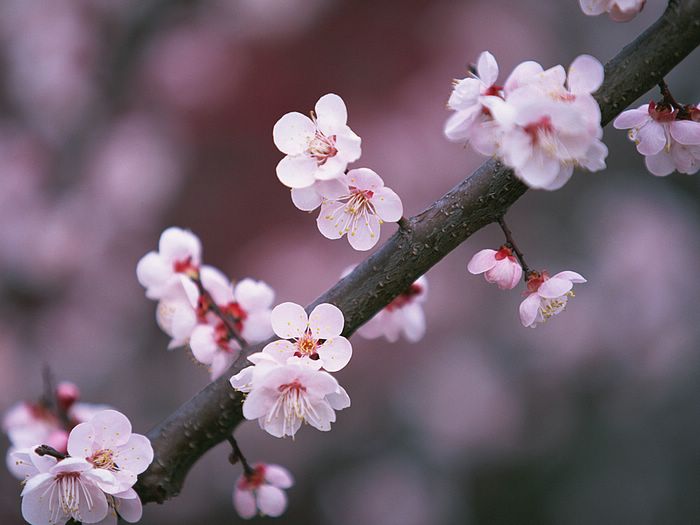
"Cherry Blossom" and "Sakura" redirect here. For other uses, see Cherry Blossom (disambiguation) and Sakura (disambiguation).
A cherry blossom is the flower of any of several trees of genus Prunus, particularly the Japanese Cherry, Prunus serrulata, which is called sakura after the Japanese (桜 or 櫻; さくら).]Cherry blossom is speculated to be native to the Himalayas.Currently it is widely distributed, especially in the temperate zone of the Northern Hemisphere such as: Europe, West Siberia, South Korea, China, Japan, United States, etc.
Many of the varieties that have been cultivated for ornamental use do not produce fruit. Edible cherries generally come from cultivars of the related species Prunus aviumand Prunus cerasus.
แนวความคิดในการทำเอาต้น Cherry Blossom หรือที่คนไทย รู้จักกันว่าต้นซากุระ มาปลูกในกรุงวอชิงตัน ดี.ซี. เริ่มตั้งแต่ปี พ.ศ. 2428 โดยหลังจากที่ Mrs. Eliza Ruhamah (นักเขียน นักถ่ายภาพ และนักภูมิศาสตร์ ผู้ซึ่งเป็นหนึ่งในคณะกรรมการบริหารหญิงคนแรกของ National Geographic Society) ได้กลับมาจากการเยือนประเทศญี่ปุ่น เธอได้เสนอให้สำนักงานอาคารสถานที่ของรัฐ (The Office of Public Buildings and Grounds) นำเอาต้น Cherry Blossom มาปลูกในกรุงวอชิงตัน ดี.ซี. แต่ข้อเสนอของเธอก็ไม่ได้รับการสนับสนุน
ต่อมา Dr. David Fairchild นักสำรวจพันธุ์พืชและเจ้าหน้าที่ของกระทรวงเกษตรของสหรัฐฯ ได้นำต้น Cherry Blossom จำนวน 100 ต้นมาจาก Yokohama Nursery Company ประเทศญี่ปุ่นมาทดลองปลูกในพื้นที่ส่วนตัวของเขาที่เมือง Chevy Chase มลรัฐแมรี่แลนด์ เขาประสบความสำเร็จในการการทดลองปลูกจึงสนับสนุนให้นำต้น Cherry Blossom มาปลูกบนถนนสายต่างๆ ในเขตกรุงวอชิงตัน ด้วยความร่วมมือของผู้สนับสนุน นอกเหนือจากการซื้อต้น Cherry Blossom ที่มีการวางแผนในเบื้องต้นแล้ว Dr. Jokichi Takamine นักเคมีผู้ค้นพบฮอร์โมนอะดรีนาลีน ซึ่งคณะนั้นพำนักอยู่ในกรุงวอชิงตัน ดี.ซี. ได้บริจาคต้น Cherry Blossom อีก 2,000 พันต้นในนามของกรุงโตเกียวเพื่อนำมาปลูกที่บริเวณเรียบแม่น้ำ Potomac และต้น Cherry Blossom จำนวน 2,000 ได้ถูกส่งมาที่กรุงวอชิงตัน ในวันที่ 6 มกราคม พ.ศ. 2453
ในวันที่ 19 มกราคมในปีเดียวกันผู้สำรวจของกระทรวงเกษตรของสหรัฐฯ ได้ตรวจพบว่าต้น Cherry Blossom เหล่านั้นมีการระบาดของแมลง ปลวก และโรคในพืช กระทรวงเกษตรจึงแนะนำให้เผาทำลายต้นไม้ทั้งหมดทิ้ง ซึ่งก็ได้รับอนุมัติจากผู้มีอำนาจของสหรัฐฯ อย่างไรก็ตาม ต้น Cherry Blossom ที่มีขนาดที่ใหญ่ที่สุดจำนวน 12 ต้นถูกเก็บไว้เพื่อทำการศึกษาเกี่ยวกับแมลงและโรคที่ติดมากับต้นไม้ โดยมีการใช้ควบคุมการกระจายของแมลงและโรคเป็นอย่างดี
รัฐมนตรีต่างประเทศของสหรัฐฯ ได้แจ้งให้ประเทศญี่ปุ่นทราบ ซึ่งทุกฝ่ายที่เกี่ยวข้องก็สามารถเข้าใจกับสถานการณ์ที่เกิดขึ้น และไม่ก่อให้เกิดความขัดแย้งใด Yukio Ozaki นายกเทศมนตรีของกรุง โตเกียวและผู้ที่เกี่ยวข้องเสนอให้มีการบริจาคต้น Cherry Blossom ครั้งที่สอง โดยครั้งนี้จะบริจาค เป็นจำนวน 3,020 ต้น ในวันที่ 14 กุมภาพันธ์ พ.ศ. 2455 ต้น Cherry Blossom หลากหลาย พันธุ์จำนวน 3,020 ต้นถูกส่งมาถึงเมืองซีแอตเทิล และถูกส่งต่อมายังกรุงวอชิงตัน ดี.ซี. ในปี พ.ศ. 2478 เทศกาลต้น Cherry Blossom (Cherry Blossom Festival) ถูกจัดขึ้นเป็นครั้งแรกโดยความร่วมมือของหลาย ฝ่ายที่เกี่ยวข้อง และเทศกาลนี้ได้กลายเป็นเทศกาล ประจำปีของกรุงวอชิงตัน ดี.ซี.
ในวันที่ 11 ธันวาคม พ.ศ. 2484 ต้น Cherry Blossomจำนวน 4 ต้น ได้ถูกตัดลงเพื่อเป็นการแก้แค้นที่ทหารญี่ปุ่นได้ โจมตีกองทัพของสหรัฐฯ ที่ท่าเรือเพิร์ล (Pearl Harbor) ฮาวาย เหตุผลในการทำลายต้น Cherry Blossom ไม่ได้รับการ สนับสนุน ต่อมาต้น Cherry Blossom ถูกเรียกว่าเป็นต้นไม้ จากตะวันออก (ไม่ใช่จากประเทศญี่ปุ่น) เพื่อป้องกันการถูก ทำลายเมื่อเกิดสงครามโลกครั้งที่ 2 เมื่อ สงครามโลกครั้งที่ 2 สิ้นสุดลงพบว่าต้นซากุระซึ่งแม่พันธุ์ของต้นไม้ ที่ส่งมาให้สหรัฐฯ ถูกทำลายไปเป็นจำนวนมาก ประเทศญี่ปุ่นจึงขอให้สหรัฐฯ ส่งต้นไม้พันธุ์นั้นกลับไปที่โตเกียวเพื่อเก็บรักษาไว้ที่แหล่งกำเนิด ซึ่งการแบ่งปันและช่วยเหลือนี้ได้กลายเป็นสัญลักษณ์และ มิตรภาพที่แน่นแฟ้นระหว่างสหรัฐฯ กับประเทศญี่ปุ่น






